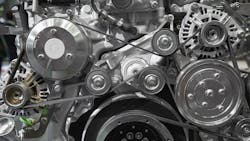Engine braking evolves to answer needs of today’s vehicles
Fleets everywhere are continuing to explore a seemingly endless list of new and creative options for improving fuel economy, reducing emissions, and advancing sustainability solutions. It’s now more the norm than the exception.
Among their efforts are shifting to alternative fuel sources, or for the traditional diesel-powered vehicles, moving to downspeeding the engine, downsizing the engine, adding aerodynamic devices, and spec’ing low rolling resistance tires and other fuel-saving systems.
All in all, fleets now have a wonderful menu from which to select a host of effective solutions to combat climate change.
See also: Navistar comes ‘full circle’ with new powertrain
However, many of these answers also will decrease the ability of the vehicle to slow down or maintain a proper speed on grades, while placing additional burdens on the engine and other powertrain components, including the engine brakes. In many instances these answers can impede and decrease important engine braking power and can also create drivability issues.
Fleets have been asking for solutions to these problems and testing has confirmed that high power density (HPD) engine brakes can eliminate these complications and even complement downspeeding and other fuel-saving initiatives, such as the switch to gaseous fuels.
Jacobs’ two-stroke HPD technology realizes up to 1.5 times the available braking performance of a conventional compression release engine brake.
Designed as a key part of the engine, HPD is integrated into the valve-train. The braking system consists of two dedicated rocker arms and two collapsible bridges per cylinder. This allows a second braking event to occur during each engine cycle. The two-stroke braking manipulates the exhaust and intake valves during the braking event, allowing for optimal air flow.
The HPD electronic technology is controlled through an ECU and also interfaces with other key systems in the vehicle including adaptive cruise control, the electronic stability program, road speed limiter, ABS, and transmission-related functions.
Regardless of vehicle speed, HPD allows for constant braking power at all times throughout the vehicle’s entire RPM range.
The HPD system also can be controlled by the driver like any traditional compression release engine brake. This creates a more favorable driving experience because the braking power provided by the system avoids the need for extensive downshifting while delivering higher braking power at lower RPMs. Additionally, the HPD system can be used with cruise control and in stop-and-go city driving.
While HPD works well with diesel-powered vehicles, it is also a good choice for use with vehicles powered by gaseous fuels. These trucks continue to attract the interest of fleets, especially those operating in California.
Unfortunately and with lower compression ratios, gaseous fuel-powered vehicles also inherently lose braking power compared to diesel equivalent vehicles. That problem, too, can now be solved with HPD. So much so that the performance gap has been eliminated with HPD to the point where gaseous-powered vehicles are now performing better in many situations than equivalently spec’d diesel-powered vehicle.
Given the constant evolution of the engine, powertrains, and even the complete vehicle, engine braking technology has also had to evolve. And it has.
HPD is the next step in that evolution. The technology, after more than 10 years of development, has been highly validated with OEMs in a variety of vocations and applications, and successfully demonstrated with fleets and drivers around the world.
Best of all, it is available today. All an interested fleet has to do now is ask for it, so that it will be included in future engines.
Doing so will go a long way to make high power density more the norm than the exception.
Robb Janak is director of new technology at Jacobs Vehicle Systems. His objective is to develop technology to meet customers’ future needs. While at Jacobs, Janak accumulated more 25 years of engine brake, valve-train, and variable valve actuation development experience.
About the Author

Robb Janak
Director of new technology at Jacobs Vehicle Systems
Robb Janak is director of new technology at Jacobs Vehicle Systems. His objective is to develop technology to meet customers’ future needs. While at Jacobs, Janak accumulated more 25 years of engine brake, valve-train and variable valve actuation development experience. He began his career at Jacobs in manufacturing support and went on to hold positions in production and product support using Design for Six Sigma and leading Kaizens in Lean Manufacturing. He managed several product development groups and Jacobs’ engineering laboratory where he had responsibility for launching numerous products for OEMs globally.
Janak has contributed to more than 12 U.S. and international patents involving valve train components, systems, and processes. He holds a Bachelor of Science degree in Mechanical Engineering and Materials Science from the University of Connecticut.
